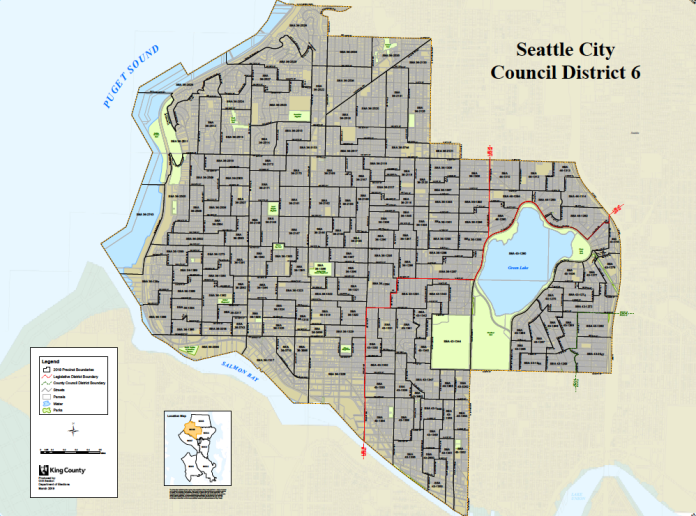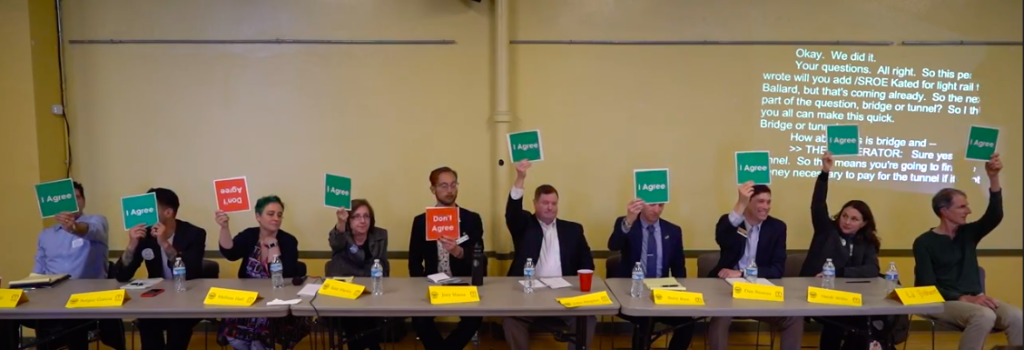
On Tuesday night ten of the twelve confirmed candidates for Seattle’s District 6 City Council race attended a two-hour-long debate focused on transportation, housing, and sustainability sponsored by the MASS coalition. (The Urbanist is a member of the MASS coalition.) Candidates John Lisbin, a vocal opponent of the Mandatory Housing Affordability program, and Jeremy Cooke, a North Ballard resident, did not attend.

Setting the stage for evening, moderator Heidi Groover asked the candidates to describe how they got there, a question that was meant to be literal, not figurative, although some candidates were eager to share their personal journey to running for office.
A few of the candidates who lived nearby walked. Others bussed, biked, or carpooled. John Peeples, an engineer who has presented himself as the City Hall opposition candidate in the race, proudly declared he had driven to the debate in Phinney Ridge from downtown in sixteen minutes. Another admitted solo driver was former Seattle City Councilmember Heidi Wills. In a remark that felt a bit behind the times, Wills bragged that she was the second person in Washington State to buy a hybrid vehicle and that she had driven that same vehicle to the event. That statement might have sounded a lot more revolutionary back in 2003 when Wills was voted off the the council.
With such a crowded race, the onus was on the candidates to distinguish themselves and their platforms. However, it was difficult at times to parse out differences. With few exceptions, most candidates positioned themselves as pro-transit, pro-density, and eager to address urgent issues like climate change and housing affordability. Even Peeples, who sprinkled right-wing radio styled asides throughout his responses, praised Metro transit and voiced support for some efforts to increase urban density.
Automated Camera Enforcement
On the question of automated camera enforcement for traffic, most of the candidates came out in support of using automated cameras to ensure that vehicles do not block intersections and pedestrian crossings. Police officer Sergio Garcia was opposed to using automated cameras, as was Peeples, who was also only candidate to oppose reducing speed limits in areas where it would increase safety for pedestrians and cyclists.
Melissa Hall, an attorney with a background in land use policy, emerged as a standout in topic by first acknowledging how state law continues to prohibit the use of automated cameras for enforcement, and then by promoting how changes to the location of traffic signals has successfully been used to prevent drivers from blocking intersections in Europe. At the end of the debate, Hall also used her final statement to share her vision for keeping transit lanes moving by implementing dual transit only and tolling lanes, with the idea that the toll charged to the driver should reflect “the cost of the person being in the transit lane.”
Race and Equity
With only two candidates of color and three women represented in the race, responses to questions around racial equity felt a bit strained at times. Garcia, whose parents immigrated to the US from Honduras, shared personal stories about his experience as a person of color, but did not share specifics on how his commitment to racial equity would shape his decisions as a councilmember. Hall introduced her personal mantra of “Plan with, not for,” a statement on racial equity that candidates repeated in their remarks.
Terry Rice, a small business owner, distinguished himself by referring to the City’s use of Race and Equity Toolkits (RETs), which address potential impacts of City programs and policies on racial equity goals, saying that such analysis should “infiltrate every part of government and every policy.”
While other candidates referred to the race-based disparities that have resulted from Seattle’s history of redlining and exclusionary practices, Ed Pottharst, an urban planner and longtime city employee, was the only candidate to explicitly connect this history to today’s single-family zoning.
Later on, when asked how to stop displacement of lower income earners and people of color from Seattle, Pottharst suggested the City expand its housing trust fund and work to create more affordable homeownership opportunities.
Accessory dwelling units (ADUs) were a popular choice among candidates as an anti-displacement tool that could both add density and increase access to affordable housing throughout the City, as was changing city-wide zoning to allow for the construction of triplexes and quadplexes in single-family zones. In this regard, Kate Martin, the urban planner behind the failed initiative to transform the Alaskan Way viaduct into an elevated park, stood out for her opposition both to zoning changes in single-family zoned areas and proposed ADU reforms that promote backyard cottage construction, although in her end remarks she also claimed to be a “yes in my backyard” candidate.
Controversial Projects
When asked about a fabricated “controversial” scenario in which the Seattle Department of Transportation (SDOT) proposes to redesign a street in order to reduce deaths and injuries, but with the caveat that it will slow traffic by 30 seconds each way and lead to a loss of 50 parking spaces, the respondents referenced the need for greater communication between the City and public.
Joey Massa, a veteran who lives on a house boat, stole the limelight with one of the night’s most memorable quips for how he would handle the controversy. “I got my start in this city as a bouncer, and one of the most vital skills for a bouncer is clear and effective communication.”
While Martin criticized the City’s current use what she defined as “super top-down” decision making and waxed poetic about the neighborhood planning process of the 1990’s, Hall made the case for creating objective standards for street redesigns that could be applied throughout the city. “The fact of the matter is, as much as people care about what happens in their backyards, you’re going to make biased decisions in your backyard, because that’s going to affect you in a different way than it affects the rest of the city,” Hall said.
Physician and former healthcare exchange president, Jay Fathi likened managing such a controversy to the work he has undertaken in healthcare, stating he would be sure to implement plans that were “evidence-based” and “use data to track and follow outcomes.”
Climate Change
The need to address climate change was a theme throughout the evening and with some small exceptions, candidates seemed largely in agreement that improving public transit and increasing urban density offered the best means for Seattle to reduce its carbon footprint. Pottharst became the first candidate to call for congestion pricing Downtown Seattle as a means for funding the acceleration of light rail completion. When asked later about congestion pricing, of all the candidates only Pottharst, Fathi, Wills, and Strauss expressed support.
Martin called for Seattle to follow Portland’s example and implement a more detailed climate action plan, a statement that was later echoed by Rice.
Regressive Taxes and Housing Affordability
Referencing the fact that Seattle has the most regressive tax system in the country, Groover asked the candidate to explain how they would take on the challenge of raising money for much needed investments, like affordable housing, in under such an inequitable system. Candidates proposed a few specific plans for generating revenue. Strauss put forth the idea of creating a vacant rental tax. The tax, which would kick in after 90 days of vacancy, would only apply to property owners with more than 50 units of rental housing in Seattle.
Revisiting a head tax was advocated for by Pottharst, who emphasized that such a tax could be made to be more acceptable to businesses if it were to tax gross profits instead of gross revenue. Pottharst also advocated for making the tax progressive by adding rate tiers that would tax higher profit earning businesses more than those who earn less.
Hall was the only other candidate to state support for a future head tax. Auditing city departments and programs for effectiveness and finding means by which to cut budgets was the preferred solution of several of the candidates, including Martin, who criticized the Seattle Promise Scholarship, which pays for two years for community college for Seattle high school graduates, and Peeples who said people who struggling to afford the cost of living in Seattle should move in with roommates and find higher paying jobs. “We have a perfectly fair taxing system, except that they keep adding more taxes,” Peeples said.
Bike Lanes and Sidewalks
Finding a way to complete the Bicycle Master Plan received broad support among candidates, but opinions differed regarding the District 6 hot topic of how to complete the 1.4 mile long “missing link” on the Burke Gilman Trail. Early on Peeples voiced his opposition to the City’s preferred alternative, which runs on Shilshole Avenue NW, a sentiment that was shared by Martin who said she was “appalled by that route.”
The sensitivity of the local issue was made clear by how Fathi, Strauss, and Wills all put forth qualified responses. Wills later announced her support for an elevated alternative for the Burke Gilman on Shilshole similar to the Highline Park in New York City, but did not explain how much such a project would cost or how it would be paid for.
Some unusual ideas also surfaced when the candidates were asked for how the City should address its 45,000 blocks of missing sidewalks. Hall suggested training residents to build the sidewalks themselves, an unusual solution that seemed to gain traction among some other candidates, despite the fact that the real cost of sidewalk construction comes from the drainage that comes with it, a point made by Pottharst. No one referenced the current Home Zone Pilot in Licton Springs, which is seen as an affordable alternative to sidewalk installation.
Ballard Light Rail Tunnel

Only Hall and Massa expressed support for an elevated light rail option over a tunnel for future light rail in Ballard. Elevated light rail in both Ballard and West Seattle would be more affordable than tunnel options. Candidates were not able to provide comments on this topic and did not revisit the topic of the tunnel option later in the debate.
Constructing a tunnel beneath the Ship Canal has attracted increased support recently from politicians like Mayor Jenny Durkan and King County Executive Dow Constantine, despite the fact that such a plan would exceed the Sound Transit’s current $5 billion budget for the light rail project and require third party funding.
Natalie Bicknell Argerious (she/her) is a reporter and podcast host at The Urbanist. She previously served as managing editor. A passionate urban explorer since childhood, she loves learning how to make cities more inclusive, vibrant, and environmentally resilient. You can often find her wandering around Seattle's Central District and Capitol Hill with her dogs and cat. Email her at natalie [at] theurbanist [dot] org.

